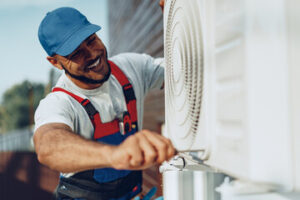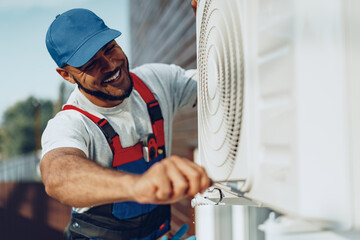Buying a new air conditioner is a big investment. Make sure it’s installed properly so you can enjoy years of efficient cooling without paying for costly repairs and replacement.
The air conditioning installation process starts with an in-home estimate. This includes a manual j load calculation to ensure the AC system is sized correctly for your home. Contact AIR CONDITIONING INSTALLATION MILFORD OH for professional help.
Air conditioning used to be considered a luxury but today it’s an essential part of most homes. It contributes to your daily comfort, health, productivity, and even your home’s market value. It’s important to choose the right system based on your home’s size, cooling needs, and energy costs. It’s also critical to install the unit properly to ensure it’s functioning at full capacity.
Before beginning your installation, a qualified technician will evaluate your home’s cooling infrastructure and address any issues that may affect the performance of your new AC unit. This includes assessing ductwork leaks, inspecting electrical systems, and upgrading circuit breakers and wiring if necessary.
After the inspection, the installation team will disconnect and remove the old AC unit. They’ll then use a recovery machine to remove and dispose of refrigerant. This step is crucial as it’s illegal to vent refrigerant into the atmosphere. In addition, technicians will disconnect and disconnect electrical wiring and turn off the circuit breaker for the old AC unit.
Then, they’ll mount the indoor air handler on a bracket that’s secured to the wall. This step requires precise measurements and levelling tools to achieve the desired results. The installers will also check that the air conditioner is positioned correctly in order to provide optimal cooling throughout your home. It’s important to note that a unit that isn’t positioned correctly will waste energy and lead to inefficiencies.
Next, the installation team will create openings in the walls for the passage of refrigerant lines, electrical wiring, and drainage pipes. This process is typically the longest and most complex step in air conditioner installation. Professional installers will carefully and securely seal these openings to prevent pests from entering your home, and they’ll double-check all of the connections between the indoor and outdoor units.
Finally, the technician will charge your new air conditioning system with refrigerant according to manufacturer specifications. This is a vital step because under- or overcharging can affect how well your system performs. Finally, the installation technician will run your new air conditioner through a thorough test to make sure everything is working as it should. They’ll also go over any basic maintenance tasks you can do on your own and provide a schedule for when you should book your first maintenance service.
Maintenance
Air conditioners are complex machines that require specialized skills and knowledge to install and maintain. While many handy homeowners can tackle some aspects of AC maintenance, involving a professional will ensure your new system performs efficiently for years to come.
Before installing your air conditioning system, a technician will evaluate the existing system and ductwork. This will help them identify any issues that need to be addressed, such as leaks, inefficiencies, or improper ductwork design. During the pre-installation inspection, your HVAC technician will also check the refrigerant levels and calibrate the thermostat to maximize efficiency.
After the installation of the new air conditioning unit, a technician will set up the outdoor unit on a composite pad. This is recommended over concrete pads because they can deteriorate over time and lead to cracks in the unit. In addition, the composite pad will help absorb vibrations and noise from the unit.
Once the outdoor unit is in place, a technician will connect it to the indoor unit by connecting a copper line set and service rod. They will also set up and install a disconnect box. Finally, they will test and adjust operating temperatures, air flow patterns, and timer functions.
During the AC replacement process, your technician will discuss new technology like heat pumps and ductless systems that can help save energy and money. They will also work with you to find financing and incentives to help make the upgrade affordable.
The ductwork is a critical component of an efficient cooling system. It is important to have the ductwork properly inspected, cleaned, and sealed before installing your new air conditioner. In addition, the ductwork should be properly insulated to reduce air loss and improve comfort.
A condensate drain line is necessary to properly dispose of moisture produced by the air conditioner. It is important to plan where this line will discharge, as it must be away from heat sources and high traffic areas. It should also be positioned so that it does not block any intake or exhaust vents. The evaporator and condenser should be mounted on a level surface with at least 12-24 inches of clearance for proper airflow.
Replacement
If you have an older AC system that is breaking down frequently or has high energy bills, it may be time to consider replacing it. Modern air conditioning systems provide efficient cooling that can keep your entire house or individual rooms comfortable and safe, even in the hottest temperatures of summer. They also add value to a home and make it more attractive to potential buyers.
The installation process begins with an in-home consultation to assess your air conditioning needs and determine the right unit for your space. The contractor will also check the condition of your home’s existing infrastructure, such as ductwork and electrical connections, to identify any issues that could affect performance.
Once the contractor has chosen a new air conditioner, they will remove the old unit from its outside location and prepare to install the new one. They will also install the necessary ductwork, and if needed, will replace the insulation to ensure proper airflow and temperature control. The technician will then test the new system to ensure that it meets all manufacturer and local standards.
Your existing ductwork should be inspected for leaks, blockages, and inefficiencies that can decrease the efficiency of your new AC system. If the ductwork is too small, the new AC system will not be able to effectively cool your home. On the other hand, an overly large air conditioner will waste energy by constantly turning on and off, causing a high energy bill.
If you have a window unit, the technician will also inspect your windows to see how well they are sealing and insulating. They will also examine the foundation of your home to make sure it is sturdy enough to support the weight of a new AC unit, and they will install any additional supports as needed. They will also replace the concrete pad if it is damaged, and install a composite one that can withstand the elements. In addition, they will check the electrical wiring and circuit breakers to ensure that they are up to code and can handle the load of a new air conditioner.
Warranty
Depending on the manufacturer and your particular unit, warranty coverage may vary significantly. It’s essential to read the specific terms and conditions to avoid a situation in which you must pay for costly repairs due to incorrect actions or neglect.
Air Conditioning Unit Registration
Regardless of whether you’re installing a new AC system or replacing an existing one, it’s vital to register the unit with the manufacturer to activate and maintain any warranty. Failure to do so could result in a shorter warranty period or less comprehensive coverage.
Professional Installation
Many manufacturers require that their HVAC products be installed by licensed professionals to retain full coverage. This is because improper installation could lead to malfunctions, which would subsequently void the warranty. It’s also important to follow any registration guidelines outlined in the product’s terms and conditions.
Proper Maintenance
Most manufacturers require homeowners to regularly have their HVAC systems inspected and serviced by qualified technicians. This is an important step for maintaining the longevity of an AC unit, as it reduces the likelihood of unexpected malfunctions and other problems. Failure to follow the required routine maintenance schedule might void an air conditioner’s warranty.
External Factors
Generally speaking, warranties do not cover damages caused by outside factors, such as natural disasters, fire, property destruction, or power surges. Likewise, a manufacturer’s warranty typically does not cover parts or labor to repair damage caused by normal wear and tear over time.
Consider an Extended Warranty
For those seeking additional peace of mind, an extended warranty is a wise investment. While it can add to the upfront cost of an AC purchase, it can provide additional coverage for parts and labor that might not be covered by standard manufacturer’s warranties.
The cost of an extended warranty is generally no more than 20% of the total AC system price. The return on this investment is often quite high, considering the peace of mind it provides. However, it’s important to consider your own personal risk tolerance and determine if an extended warranty is right for you.
